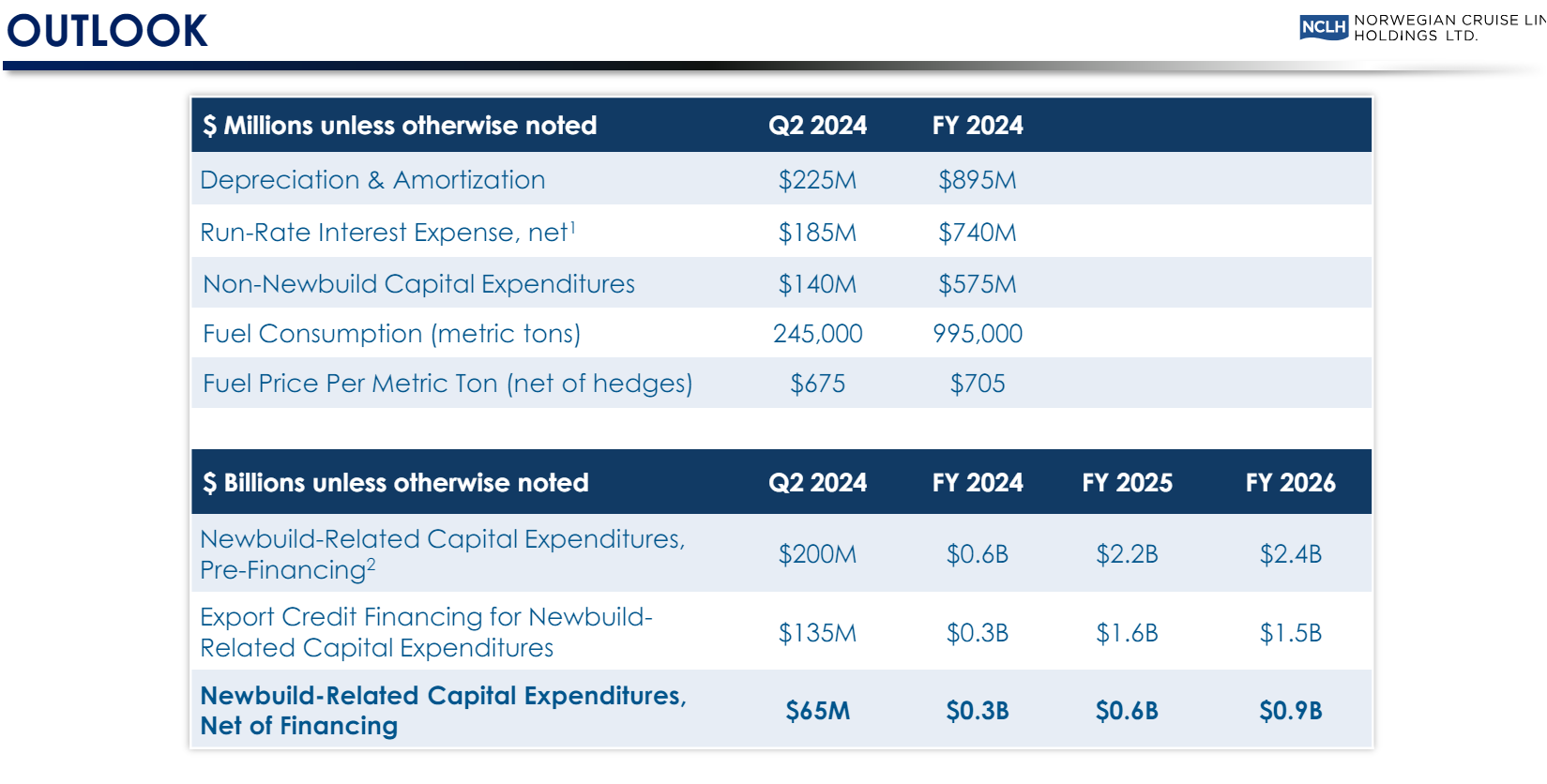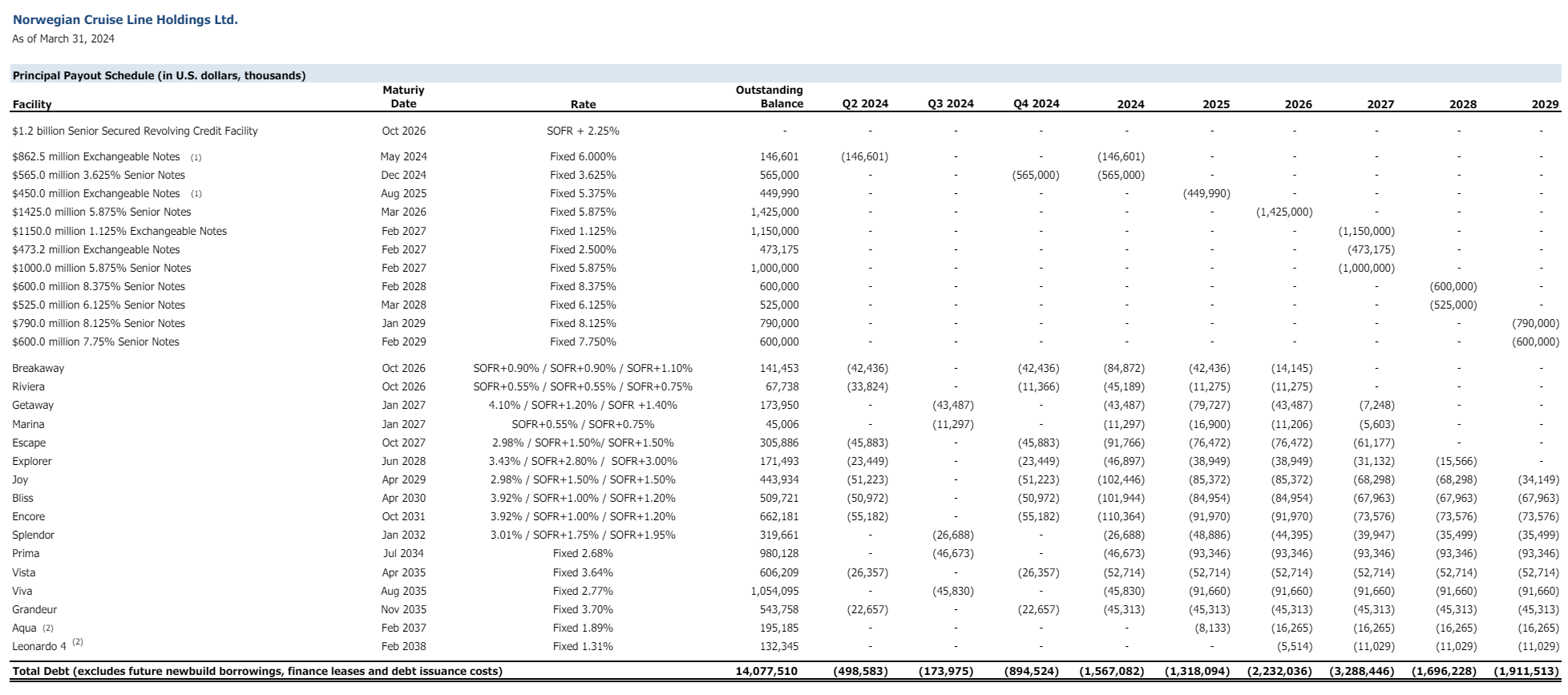

登錄


登錄
海擇短評 Haize Comment:
郵輪業的生態,一直是以對債務借新還舊來處理新船的建造需求;而大型郵輪集團能脫穎而出,來自於用更龐大的船票收入來繳付龐大的債務利息。疫情為郵輪集團帶來的存滅挑戰是,原本龐大的利息飆升到超級龐大而難以負荷。所以,觀察挪威郵輪集團(NYSE: NCL, 下稱挪威郵輪)2024Q1季報的重點,不是探索它的盈利能否還清本金,因為這不可能,而是什麼樣的財報是銀行團願意增貸的最低限度,什麼樣的財報能讓銀行團願意給到更好的利率轉貸。基於此,海擇資本解析本季挪威郵輪財報如下:
1. 4.5億美元是盈利分界線:挪威郵輪的債務利息有多高,用直觀的數據來看,Q1的Adjusted EBITDA為4,64億美元,淨利為1,700萬美元,EBITDA與淨利間的差額約4.5億美元,大體可簡化理解為一季的債務利息;也就是說,一年的利息大概是4倍,即18億美元,或者用另一個角度說,一年的EBITDA若在18億美元之內,就是幫銀行團打工還清利息,超過18億美元,才算真正(GAAP意義上)的淨利;而這一年18億美元的利息,是來自於總計170.7億美元的銀行團債務本金。所以,挪威郵輪如果只是在收入、毛利、運營利潤略超2019年同期,對集團前景無關勝敗,還不如好好地將利率最高的本金提前清償,或是用再融資談更低的利率,減少利息支出。海擇資本認為,了解了這些,才不會被各郵輪集團創新高的激情數據過度撩撥,失去對盈利能力的追求。
2. 值得追蹤的數據有限:雖然我們說財務好壞,相對無關勝敗,但其實這樣的敘述不夠精確。嚴格來說,這些從定價、銷售、入住率、運力的正向循環,即便遠超2019年的收入,仍然只能結算出低於2019年的淨利,但會有利於與銀行團的斡旋,在借新還舊與再融資之際,對談到更有利的貸款利率是有幫助的。舉例來說,Q1挪威郵輪償還了2028年到期的高利率(9.75%)債務,並在當前高利率/高通膨時期,新簽的利息最低只有1.31%(Leonado號, 2038年到期)跟1.89%(Aqua號, 2037年到期)的利率,這表現出公司的運營表現還算是讓銀行團放心的。唯一的問題是,Q1的食品成本控制得當(年減12%,達1,138萬美元)、對高企燃油價格的避險控制不錯、EBITDA利潤率超過30%、收入比2019年同期超出56%,顯然這些成長還得比Q1更好,盈利才能更逼近2019年同期。所以在諸多數據中,可能入住率、運力、預售票餘額會更值得追蹤。
3. 運力決定勝敗:在各運營指標中,若需求能高到讓入住率能維持高檔,對盈利特別有幫助的,就是運力(供給)的增加。疫情間各集團瘋狂拆船,後疫情期又瘋狂加船,這作法看起來很愚蠢。不過,能增加運力也是實力的展現,因為增加運力不是郵輪集團敢不敢的問題,真正的問題是銀行團敢不敢借款以及如果借到超高利率貸款,投資人能否認同的問題。2024年挪威集團的新建船隻數量已從5艘增加到13艘,2023年至2028年的運力複合年增長率為6%,2023年至2036年的運力複合年增長率為4%。運力之外,近年郵輪集團開始承包私人島嶼作為岸上行程的目的地,比如挪威郵輪在巴哈馬的Great Stirrup Cay及在伯利茲的Harvest Caye,深入掌握供應鏈可以增加毛利率,後續效益可以觀察。
-------
The cruise industry has traditionally managed new ship construction needs by refinancing existing debts. Large cruise groups stand out by using substantial ticket revenue to cover their heavy interest payments. However, the pandemic introduced existential challenges by significantly increasing these already substantial interest payments to unsustainable levels. Therefore, the focus when analyzing Norwegian Cruise Line's (NYSE: NCL) Q1 2024 financial report is not whether the company can pay off the principal—which is unlikely—but rather what financial metrics are minimally acceptable to banks for further lending, and what metrics would qualify for better refinancing rates. Based on this, Haize Capital offers the following analysis of Norwegian Cruise Line's financial report for this quarter:
1. $450 million is the profit threshold: To illustrate how high Norwegian Cruise Line's debt interest is, their Q1 Adjusted EBITDA stood at $464 million, with a net profit of $17 million. The difference between EBITDA and net profit is approximately $450 million, essentially representing the quarterly debt interest. Annually, this equates to about $1.8 billion in interest, which implies that any EBITDA under $1.8 billion essentially goes towards paying bank interest. Any amount over $1.8 billion represents true net profit in GAAP terms. This $1.8 billion annual interest expense stems from a total bank debt principal of $17.07 billion. Thus, if Norwegian Cruise Line only slightly exceeds the revenue, gross profit, and operating profit of the same period in 2019, it won't significantly impact the company's outlook. Instead, prioritizing the repayment of the highest interest principal early or negotiating lower interest rates through refinancing to reduce interest expenses would be more strategic. Haize Capital advises that understanding these figures is crucial to not getting overly excited by the record-setting performance data of cruise lines, thereby maintaining a focus on profitability.
2. Limited data worth tracking: Although financial health doesn't necessarily dictate success, this statement isn't entirely accurate. Strictly speaking, even revenues far exceeding those of 2019 can still result in lower net profits than in 2019. However, positive trends in pricing, sales, occupancy rates, and capacity can facilitate negotiations with banking syndicates during debt refinancing, potentially securing more favorable loan rates. For example, in Q1, Norwegian Cruise Line repaid high-interest debt due in 2028 at 9.75%, securing new loans with rates as low as 1.31% (due 2038) and 1.89% (due 2037) in a period of high interest rates and inflation, indicating solid operational performance that reassures lenders. Key achievements include a 12% year-on-year reduction in food costs to $11.38 million, effective hedging against high fuel prices, an EBITDA margin over 30%, and revenues exceeding the same period in 2019 by 56%. However, to approach the profitability levels of 2019, performance must improve beyond Q1 figures. Therefore, metrics such as occupancy rates, capacity, and pre-sold ticket balances might be more critical to track.
3. Capacity determines success: Among operational indicators, the ability to maintain high occupancy rates is greatly aided by increased capacity (supply). The practice of scrapping ships during the pandemic and rapidly adding ships post-pandemic may seem foolish. However, the ability to increase capacity showcases strength, as the real challenge isn't whether cruise lines dare to expand, but whether banks dare to lend for it, and whether investors agree with potentially high-interest loans. By 2024, Norwegian Cruise Line has increased its number of new ships from 5 to 13, with a compound annual growth rate (CAGR) in capacity of 6% from 2023 to 2028, and 4% from 2023 to 2036. Besides capacity, cruise lines have recently started leasing private islands as destination stops, like Norwegian’s Great Stirrup Cay in the Bahamas and Harvest Caye in Belize, enhancing control over the supply chain and potentially increasing gross margins, with subsequent benefits to be observed.


標籤 Label: Cruise NCL Debt Capacity RCL CCL